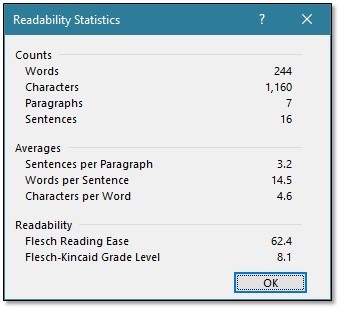Rate Your Document's Readability
How you write can vary a lot, depending on your intended audience. Lengthy words and complex sentence structures may suffice for an audience of academics, while other occasions may require the text to be readable to as many people as possible.
In addition to checking for spelling and grammar mistakes, Microsoft Word's proofing tools can also rate readability using two metrics: Flesch Reading Ease and Flesch-Kincaid Grade Level. Both methods are based on the research of Rudolph Flesch and judge readability by word, sentence, and syllable totals.
To turn this feature on in Word, go to File > Options > Proofing and enable show readability statistics uderneath "When correcting spelling and grammar in Word."

After doing so, a window with your document's readability statistics will display after each time you run the "Spelling and Grammar" tool.

The Reading Ease scale goes from 0 to 100, with higher scores being easier to read. The table below shows the relation between the Reading Ease scale and the Grade Level scale. For reference, Flesch's tests gave Sports Illustrated an average rating of 63, while the Harvard Law Review had an average rating of 32.

The Reading Ease scale goes from 0 to 100, with higher scores being easier to read. The table below shows the relation between the Reading Ease scale and the Grade Level scale. For reference, Flesch's tests gave Sports Illustrated an average rating of 63, while the Harvard Law Review had an average rating of 32.
